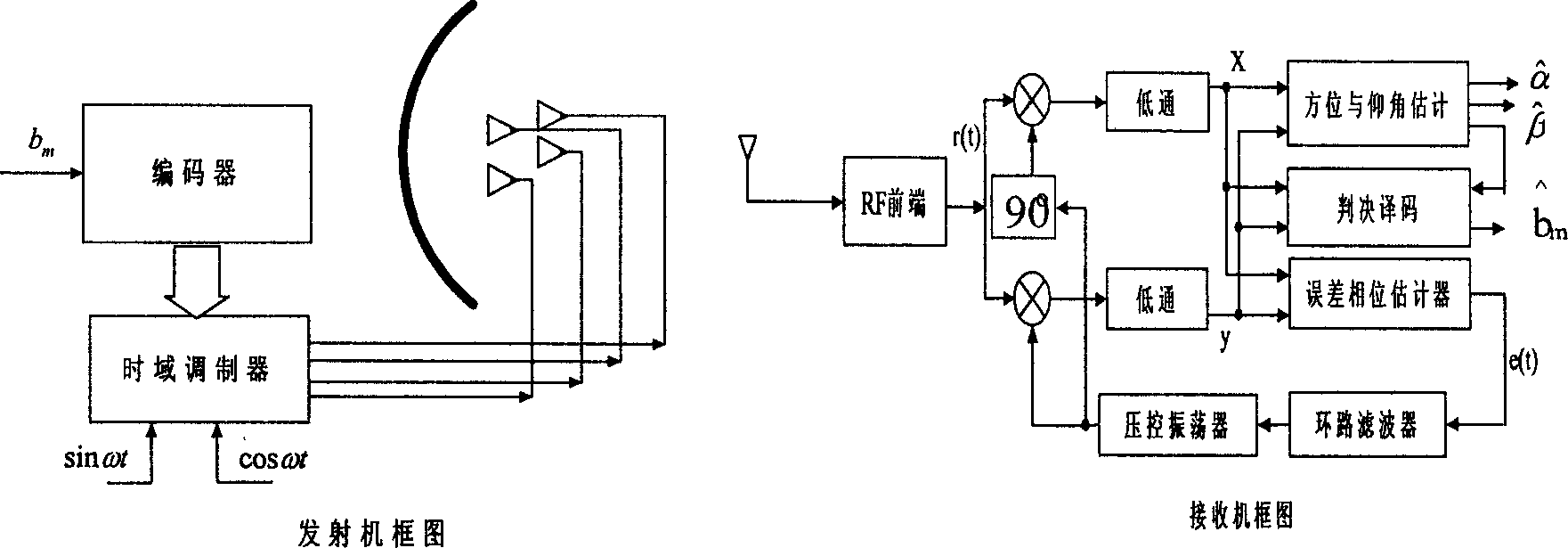Single pulse antenna time-space modulating method and device with position and elevation information
A technology of elevation angle information and modulation method, which is applied in the modulation carrier system, phase modulation carrier system, digital transmission system, etc., and can solve the problems that the light wave space modulation method cannot use microwave and microwave space modulation is difficult
- Summary
- Abstract
- Description
- Claims
- Application Information
AI Technical Summary
Problems solved by technology
Method used
Image
Examples
Embodiment 1
[0044] Such as figure 1 As shown, the monopulse antenna space-time modulation method in which the transmitted signal carries azimuth and elevation angle information in this embodiment uses an amplitude monopulse antenna to transmit signals.
[0045] (1) Design multiple antennas to transmit excitation signals: under the action of four off-focus excitation sources, four concentric off-axis beams are formed, and the beam pattern is F 1 (α,β), F 2 (α,β), F 3 (α,β), F 4 (α, β), abbreviated as F i , i=1, 2, 3, 4, the mutual geometric relationship is as figure 2 As shown, α, β are the directions relative to the central axis of the planar antenna
[0046] Azimuth and elevation angles. The selection of the four beam patterns is the same as that of the monopulse radar, which should have better sum-difference characteristics, but the difference is that all four antennas are used for transmission in this embodiment.
[0047] Let the excitation signal of each antenna beam be s i ...
Embodiment 2
[0078] Embodiment 2: If the information to be transmitted in step (3) of Embodiment 1 is subjected to 16-phase two-bit interval differential encoding, then the differential encoding scheme takes
[0079] ψ(α,β,m)=-ψ(α,β,m-2)+0.5b m πb m The quaternary information is 0, 1, 2, 3, m=1, the initial state of 2 is the same as that of the eight phases, and the azimuth and elevation angle can be measured alternately by odd and even, and the corresponding modulation can be called 16-phase space-time modulation. The communication capacity of the 16-phase time-space modulation is the same as that of the quadrature four-phase QPSK, and the space distance of the encoded signal has nothing to do with the orientation. The simulation results show that the power spectrum of the modulated signal is consistent with QPSK respectively.
Embodiment 3
[0080] Embodiment three: as figure 1 As shown, in the transmitter, the digital information to be transmitted b m It is connected with the encoder, and after encoding, it is output to the time-domain modulator through multiple channels in parallel. The other two inputs of the time-domain modulator are the sine and cosine carriers formed by the frequency synthesizer. The time-domain modulator outputs four channels of modulated signals, which are amplified by radio frequency to excite the antenna, and the space modulation is realized by the reflector antenna to form time-space modulation signals related to azimuth and elevation angles.
[0081] In the receiver, the radio wave signal is first received by a single antenna, and then sent to the radio frequency (RF) front end for amplification and mixing to the intermediate frequency. The intermediate frequency signal is divided into two channels and multiplied by the sine and cosine carrier components output by the local voltage-c...
PUM
 Login to View More
Login to View More Abstract
Description
Claims
Application Information
 Login to View More
Login to View More - R&D
- Intellectual Property
- Life Sciences
- Materials
- Tech Scout
- Unparalleled Data Quality
- Higher Quality Content
- 60% Fewer Hallucinations
Browse by: Latest US Patents, China's latest patents, Technical Efficacy Thesaurus, Application Domain, Technology Topic, Popular Technical Reports.
© 2025 PatSnap. All rights reserved.Legal|Privacy policy|Modern Slavery Act Transparency Statement|Sitemap|About US| Contact US: help@patsnap.com



